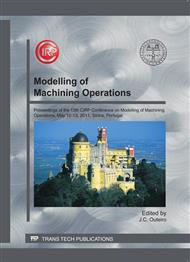p.3
p.12
p.20
p.30
p.37
p.46
p.56
p.66
p.75
Simulation of Multiple Chip Formation when Broaching SAE 5120 Low Alloy Steel
Abstract:
The paper aims to predict component conditions after each subprocess of a manufacturing process chain. A continuous simulation has to be achieved, considering the inheritance of component states. To identify functional descriptions between component conditions as input and output quantities a broaching simulation is being developed. It includes multiple chip formation with multi-toothed broaching tools and machining history of a component as well. For this purpose component conditions are extracted from and transferred to a workpiece model as an initial condition. The 2D finite element chip formation model uses remeshing for material separation allowing highly detailed surface layer characterizations. Parallel experimental studies vary process parameters, whose objective is optimization of process control and forecast of component properties. Characterization of component conditions is based on distortion analysis, cutting force and surface measurements. Comparing the specific cutting forces between simulation model and performed experiments show a reasonable agreement of results
Info:
Periodical:
Pages:
37-45
Citation:
Online since:
April 2011
Authors:
Price:
Сopyright:
© 2011 Trans Tech Publications Ltd. All Rights Reserved
Share:
Citation:


